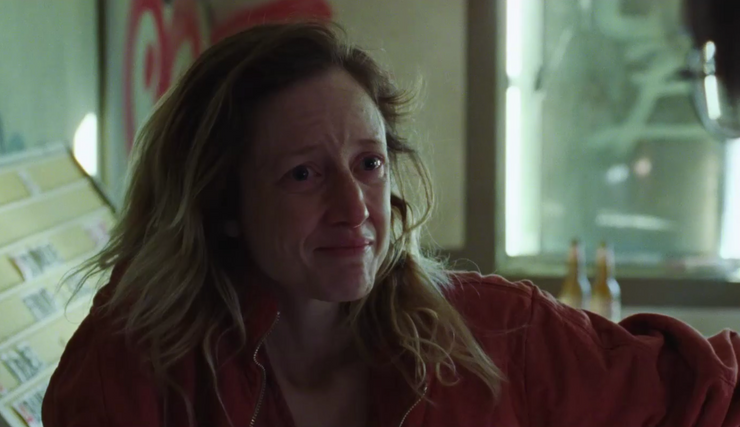A warts and all performance anchors this exploration of addiction and the value of self-belief.

The theme of substance abuse and addiction often hits close to home. Many films stumble trying to humanize the issue, but To Leslie shines. A richly textured tale written by Ryan Binaco, informed by his experiences with his own mother, Andrea Riseborough (Mandy, Possessor) stars as Leslie, a woman from West Texas who win $196,000 in the state lottery. But there’s something off about her demeanor in the footage of her first introduction, despite the promise of a better life. Cut to six years later, she’s ejected from a diny motel room without a penny to her name. She seeks out her teenage son James (Owen Teague), who, sensing her state, refuses to take her in. Leslie, left with little options, finds herself on a bus back to her hometown where she seeks out old friends Dutch (Stephen Root) and Nancy (a viscerally angry performance from Allison Janney), who also make clear that the bridge has been burnt. Worse for wear, she is found by local motel owner Sweeney (Marc Maron, GLOW, Sword of Trust). After learning about her past, he takes pity on her and offers her a place to stay and a job as a cleaner. For Leslie, this may be her last opportunity to climb from the bottom of a bottle, rouse herself from her stupor, and try to piece her life back together.
Directed by Michael Morris (Better Call Saul, among others), To Leslie swiftly outlines Leslie’s multiple sins before immersing itself in her hard fought path to rebuild her life. The film doesn’t sanitize or excuse things, planting her firmly in the fallout of her destructive behavior. Old manipulative tricks and cries for attention fail her. Wrecked relationships leave her not just isolated, but resented. This is not a place to heal, but to submit herself to one final punishment. But there’s something about the faith and lack of judgement from Sweeney that seems to strike a chord with Leslie; the film largely revolves around this burgeoning friendship. They form a genuine bond over uncomfortable truths shared and epiphanies realized, a kindling of faith that spurs Leslie on to face up to her failures and the consequences of her actions and to seek a possible path forward.

The opening credits serve as an effective montage to get us up to speed, using “Here I Am” by Dolly Parton to establish the country roots of the piece and the ballad-like structure of the film. To Leslie feels like a country song, working its way through soulful hurt and ending with a glimmer of hope. Country tracks throughout, from artists like Willie Nelson, Linda Perry, and George Jones, aptly reflect the emotional journey Leslie undertakes, and a newly recorded track over the credits from Patty Griffin adds a fitting coda. The sounds and ambiance are complemented by considered production values that feed into a visual shorthand. Cinematographer Larkin Seiple balances the surroundings to highlight Leslie’s discontent in stark daylight, and safer surrounds in the amber hues of a bar. Shot on 35mm, a grainy aesthetic complements the setting and worn down nature of Leslie’s existence.
Further texture comes from the outstanding supporting cast, most notably Maron, who manages to infuse an authentic goodness into his well-worn character. But the film rests on a tour de force performance from Riseborough. She brings nuance and humanity to a flawed but still sympathetic character, with believable, desperate shifts in mood as she transitions from her lowest ebb through this ongoing, hard-fought journey. It’s in the physicality of the character too, beyond bruises and lanky hair, in jittery movements and guarded posture, that she comes alive. Her performance is akin to an injured animal just waiting for the next wrong to befall it, or bite the hand of anyone who approaches. Riseborough’s performance is a crucial contribution to a truly sincere and skillfully wrought tale that affirms the healing power of support, and self-belief.



